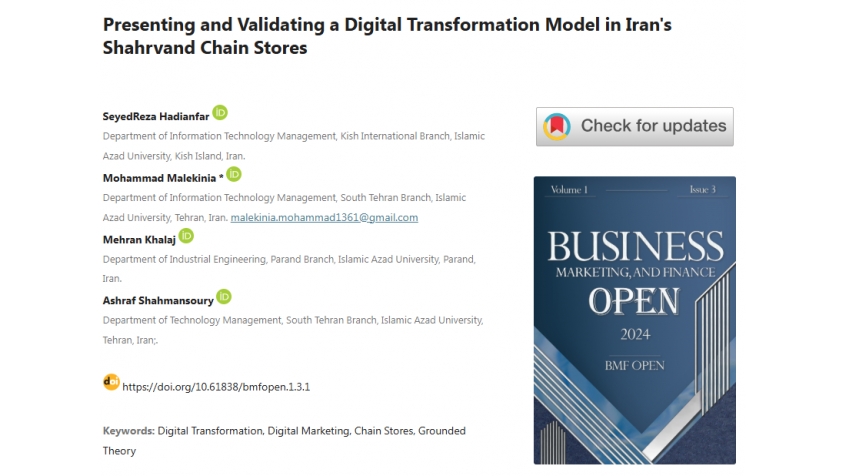
Abstract:
The present study aimed to propose a digital transformation model for chain stores in Iran, focusing on Shahrvand chain stores. The research was applied in terms of purpose, utilized a sequential mixed-methods exploratory approach for data collection, adopted a pragmatic paradigm, and used qualitative content analysis with a grounded theory approach in the qualitativephase. In the quantitative phase, it employed a descriptive-analytical survey/correlational design.The qualitative population included theoretical experts (university professors specializing in business) and practical experts (relevant managers of Shahrvand chain stores). Using the principle of saturation and purposive sampling, 20 interviewees were selected. The quantitative population consisted of all employees of Shahrvand chain stores. Using the minimum sample size calculation for confirmatory factor analysis and a multi-stage sampling method, 250 employees were chosen.Data collection methods included semi-structured interviews in the qualitative phase and researcher-developed questionnaires to validate the model from both expert and respondent perspectives in the quantitative phase. The validity and reliability of the tools were examined and confirmed in both qualitative and quantitative phases. Data analysis methods included thematic analysis using Maxqda-V18 software in the qualitative phase and descriptive and inferential statistical analysis (confirmatory factor analysis and one-sample t-test) using SPSS-V27 and SmartPLS-V3 in the quantitative phase.The findings revealed that the dimensions of digital transformation include digital user experience, inventory management, and digital marketing. Causal conditions were identified as information technology infrastructure, human resources, digital marketing strategies, and after-sales services. Strategies comprised digital technologies and software, customer service improvement, and organizational culture. Contexts involved process digitization and the analysis of logistics service quality. Outcomes included changes in customer behavior, impacts on internal operations, shifts in organizational culture, and effects on competitiveness. Finally, barriers included financial resource shortages, cultural and organizational resistance, and a lack of technical skills.The results also indicated that all relationships within the model components were significant. Ultimately, based on the identified factors, the research model was proposed, and findings demonstrated both internal and external validity based on feedback from qualitative participants and quantitative respondents.
For downloading the complete article, Click here
 https://doi.org/10.61838/bmfopen.1.3.1
https://doi.org/10.61838/bmfopen.1.3.1